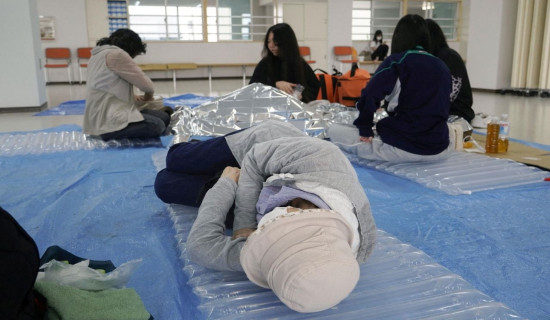- Wednesday, 30 July 2025
Sudden, Intense Exercises Harm Health
Sudden, intense exercise can cause strains, sprains, and tendinitis injuries that frequently impact the lower back, knee, and shoulder. Injury risk can be influenced by variables such as exercise kind, intensity, and personal traits (e.g., age, experience, BMI). High-intensity workouts have gained popularity in an era when fitness is increasingly glamorized and social media is flooded with transformation challenges. A healthy society must encourage physical activity, yet the negative effects of abrupt, intense exercise are becoming more well recognised, particularly for those who are untrained, have pre-existing diseases, or return to activity suddenly after a sedentary existence. The notion that "more is better" when it comes to exercise is deceptive, and the results can be dire, even fatal.
Many people are enticed to engage in abrupt, strenuous exercise because they think it would hasten their endurance, muscle growth, or weight loss. Extreme gym challenges, fitness boot camps, and HIIT (High-Intensity Interval Training) frequently promote pushing boundaries without sufficient planning. Regretfully, this disrespect for progress fails to take into account the body's reaction to stress. Over time, the human body needs to be conditioned. Abrupt high-intensity exercise can overload the metabolic, musculoskeletal, and cardiovascular systems if it is not properly adapted. The body may enter a condition of shock rather than gaining strength.
Risk of cardiac arrest
The elevated risk of cardiac events is among the most dangerous risks. Abnormal heart rhythms, high blood pressure, and, in severe cases, heart attacks can result from abrupt, intense exertion, particularly in people with undetected heart disease. Even young, seemingly healthy people have experienced cardiac arrest while engaging in strenuous exercise. Unusual strenuous activity has been shown to dramatically raise the risk of heart attacks, especially in middle-aged or older persons. Unplanned effort can have the reverse effect of the heart-protecting effects of regular, moderate exercise.
Exercises that use large weights or explosive motions, for example, may increase the chance of injury. Compared to seasoned athletes, people who are fresh to a training programme may be more prone to injury. Variables such as age, gender, body mass index, frequency and duration of exercise, and the time spent warming up and cooling down. Playing more than one sport may not always make you more prone to injury. It is essential to learn proper form to reduce joint and muscular stress. Exercise time and intensity can be gradually increased to assist the body in adjusting and lower the chance of damage. At the same time, minor problems can be kept from getting worse by identifying pain signals and modifying training accordingly. Furthermore, seeking professional advice is preferable.
Rhabdomyolysis, sometimes abbreviated as "rhabdo," is a potentially fatal illness in which muscle tissue rapidly degrades and toxic proteins are released into the blood. After vigorous exercise, this can occur, particularly in those who are not accustomed to such exertion. Rhabdo is characterised by severe muscle soreness, weakness, oedema, and black urine. Kidney failure may result in extreme situations. Hospitals around the world are seeing an increasing number of rhabdo cases as a result of the advent of extreme exercise fads. Another frequent result of sudden, hard exercise is injury. Strains, sprains, stress fractures, and ligament rips happen when the body is made to do motions for which it is not ready. In addition to causing weeks or months of disability, these injuries can result in long-term problems, including tendinitis or arthritis.
Furthermore, if high-impact exercises are performed improperly or without supervision, they can exacerbate postural abnormalities and result in long-term musculoskeletal harm. Unaware of the risks to their shoulders, knees, or spine, many amateur fitness enthusiasts try difficult moves they see online. Surprisingly, injuries or overtraining can have just as detrimental psychological effects. Those who sustain injuries may feel depressed, frustrated, or guilty, particularly if they equate their value with their ability to perform physically. Anxiety or an unhealthy exercise addiction might result from the need to "bounce back" or "keep up."
Being fit should be a lifelong process rather than a quick race. The best results from physical activity come from regular, safe engagement. The fundamentals of responsible exercise include beginning with low to moderate intensity, then increasing the duration and difficulty, and giving enough time for recuperation. Promoting safe exercise must be the main goal of public health initiatives, trainers, and medical professionals. Important precautions against injury include pre-participation health exams, warm-up exercises, staying hydrated, and paying attention to one's body.
Chronic conditions
People with chronic conditions like diabetes or hypertension, older adults with hidden cardiovascular problems, young people participating in online fitness challenges without supervision, and sedentary people trying to exercise without prior preparation should be particularly concerned about the negative effects of abrupt, intense exercise. Instead of entering into demanding fitness routines, these populations should start exercising under supervision or with professional guidance. Our society needs to change from praising intense, agonizing exercise to appreciating long-term health. Fitness shouldn't be about hitting unattainable goals or abusing the body. Rather, it ought to emphasize strength, vitality, and long-term health.
In summary, abrupt, high-intensity exercise can have more negative effects than positive ones, from serious metabolic disorders to cardiac risks and muscle damage. We must prioritise individualised, gradual, and well-informed approaches to exercise. The objective should be to invest in a lifestyle that supports the body and mind for life rather than to impress others with demanding habits.
(Dr. Lohani is the executive director at the Health Concern. lohanis@gmail.com)



-original-thumb.jpg)



-square-thumb.jpg)

-original-thumb.jpg)







